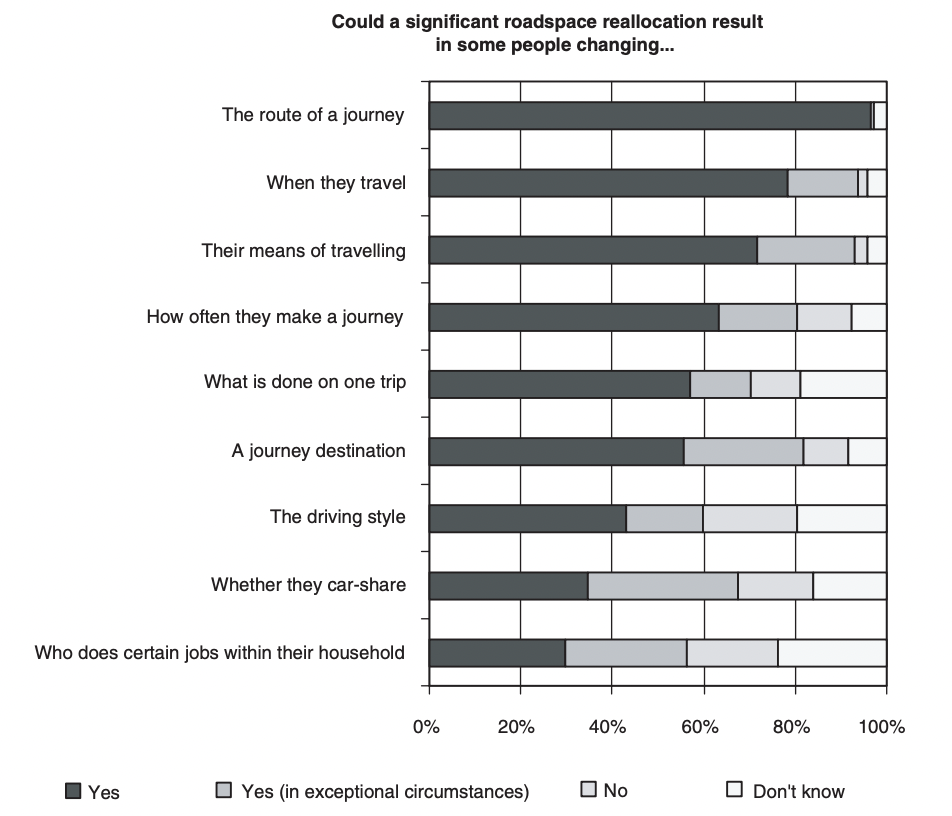Professionals refer to the ‘theory’ of disappearing traffic in the recent debate about major traffic interventions. After traffic interventions, traffic magically evaporates. What do we know about this theory?
A study (by Cairns, Hass-Klau, and Goodwin from 1998) sought to identify possible case studies of circumstances where road space had been reallocated, whether due to positively planned schemes, temporary road closures for maintenance or renewal of transport facilities, or natural disasters. Although the stimulus for change varied, in each case drivers needed to decide what to do when their typical travel patterns were disrupted, and there were valuable insights as to how they reacted.
Research on ‘disappearing traffic‘ after traffic interventions was done for cases from 1970 to 1999. The findings suggest that predictions of traffic problems are often unnecessarily alarmist and that, given appropriate local circumstances, significant reductions in overall traffic levels can occur, with people making a far more comprehensive range of behavioral responses than has traditionally been assumed. On average, 11% of traffic disappeared in the almost 70 cases evaluated (this original study found 14%). This publication was cited 224 times.
A recent study in Barcelona resulted in 14% disappearing traffic. This suggests that rather than causing widespread traffic displacement, the interventions under study have led to significant traffic evaporation. A UK study and Oslo study showed lesser results (but other positive results in creating more attractive inner cities).
Why does traffic change?
At the first level, there is the perception that road capacity for general traffic has been reduced. However, any changes are offset, or more than offset, by capacity increases on other routes, changes in traffic management, or changes in driving style, which pack more vehicles into the same space. In other words, not all examples of road space reallocation reduce road capacity.
Second, there may be a real reduction in capacity on the treated road or area, but this may be offset by adequate spare capacity on alternative routes or at other times of the day. Consequently, people may change their route or journey time, but the number of trips and vehicle mileage will likely remain relatively unchanged.
The third situation is inadequate, additional capacity on other routes, or at different times, either due to the nature of the network, the overall congestion level, or the scheme’s comprehensiveness.

Future research in city logistics
The feasibility of scaling up the successes of local schemes into more comprehensive initiatives is currently unclear. However, this is a critical issue for future exploration, given the opportunities such plans offer to achieve traffic reduction, urban regeneration, more efficient use of economic resources, and other national policy objectives.
However, more research focused on city logistics and on-demand taxi transport (and the impact of traffic interventions) is almost non-existent. A study from Oslo concluded: “Our results show that despite being negatively affected by increased congestion and road blocking, truck drivers usually manage to cooperate with transport planners to adapt to the changes. However, consequences like increased time pressure, stress, and frustration severely reduce the quality of their work day. The investigations show that mitigating measures like allocating urban space and prioritizing freight traffic are important, and even more so at the time of capacity change implementation”.
A study from Norway found that truck drivers adapted less than other traffic by avoiding a tunnel under construction, and the consequences for drivers were mainly more stress and frustration. This study concluded: “A scarcity of empirical studies on how changes in the general transport system affect truck drivers and the freight industry causes uncertainties in assessments and policymaking”.
Cairns, Hass-Klau, and Goodwin concluded (in 2001) that well-designed and well-implemented schemes to reallocate road space away from general traffic can help to improve conditions for pedestrians, cyclists, or public transport users, without significantly increasing congestion or other related problems. Moreover, schemes can help achieve benefits, including accident reductions, air-quality improvements, reduced neighborhood severance, increased business investment, more attractive living, and working surroundings, and improved retail vitality.
For city logistics: more research is needed to provide results that can lead to “actionable” improvements in city logistics.
Walther Ploos van Amstel.
Based on: Cairns, S., Atkins, S., & Goodwin, P. (2002, March). Disappearing traffic? The story so far. In Proceedings of the Institution of Civil Engineers-Municipal Engineer (Vol. 151, No. 1, pp. 13-22). Thomas Telford Ltd.
